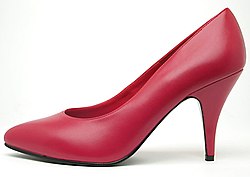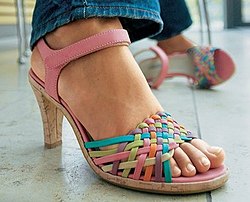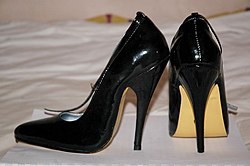High heels
High heels are shoes where the heels are much higher than the toes. They are a fashion item, usually for women. Cowboy boots and 'Cuban heels' are shoes worn by men with high heels.
Look
Mid-height heels are from 2½ to 3½ inches (6.2 to 8.5 cm). They are an intermediate between standard heels and stiletto heels, which are from 4 to 10 inches. The extreme heels are made of steel, and very narrow at the base: 0.4 inches or less. These have been widely criticised for the health risks regular wear would bring. They have also been criticised by feminists.[1] If the soles of the shoes are also raised, then they are a quite different kind of shoe: the platform shoe.[2]
Wedgies or, more properly, shoes with wedge heels, are a compromise type. They raise the heels, and are much more stable than standard high heels. Wedges for women were popularized by Salvatore Ferragamo who introduced the design to the Italian market in the late 1930s.[3]
Assessment
Advantages
Reasons for wearing high-heels, which are almost exclusively aesthetic, include:[4][5]
- They change the angle of the foot with respect to the lower leg, which accentuates the appearance of calves
- They change the wearer's posture, requiring a more upright carriage and altering the gait in what is considered a seductive fashion
- They give you extra height - Heelser Archived 2022-11-04 at the Wayback Machine
- They make the legs appear longer
- They make the foot appear smaller
- They make the toes appear shorter
- They make the arches of the feet higher and better defined
- They make the lower leg muscles more defined
Disadvantages
Reasons against wearing high-heels, which are almost exclusively health and practicality reasons, include:
- they may cause foot pain
- they increase the chance of sprains and fractures
- they may create foot deformities, including hammertoes and bunions
- they may cause unsteady walking
- they may shorten the wearer's stride
- they may make the wearer unable to walk on some surfaces
Conclusion
There are so many types of shoe, and so many differences between people that no type will suit everyone. It is obvious that the higher the heel, the riskier the shoe. The more sensible versions are quite safe; the extreme versions seen on fashion show catwalks are not for everyday wear. A lot depends on their use. Nurses tend to wear flat shoes; office staff may prefer high heels. Despite the critics, high heels have been around for a long time, and are probably going to stay.
- Imelda Marcos: a collection of 2700 pairs of shoes.[6]
High Heels Media
A pair of high-heeled court shoes
A pair of stiletto-heeled court shoes
Women's high-heeled shoes with dyed black harp seal fur, by Inuk designer Nicole Camphaug
References
- ↑ Heights of madness - New Humanist
- ↑ "Glossary of terms for women's shoe styles". Archived from the original on 2009-05-15. Retrieved 2010-09-23.
- ↑ Bergstein, Rachelle 2012. Women from the ankle down: the story of shoes and how they define us. New York: Harper Collins, p20/22. ISBN 978-0-06-196961-4
- ↑ Women pay attention to shoe heels: besides causing schizophrenia they might affect your pelvic floor muscle activity!![dead link]
- ↑ High heels 'may improve love life' - BBC News
- ↑ Morrow, Lance (31 March 1986). "The shoes of Imelda Marcos". New York Times. http://www.time.com/time/magazine/article/0,9171,961002,00.html. Retrieved 23 September 2010.
















